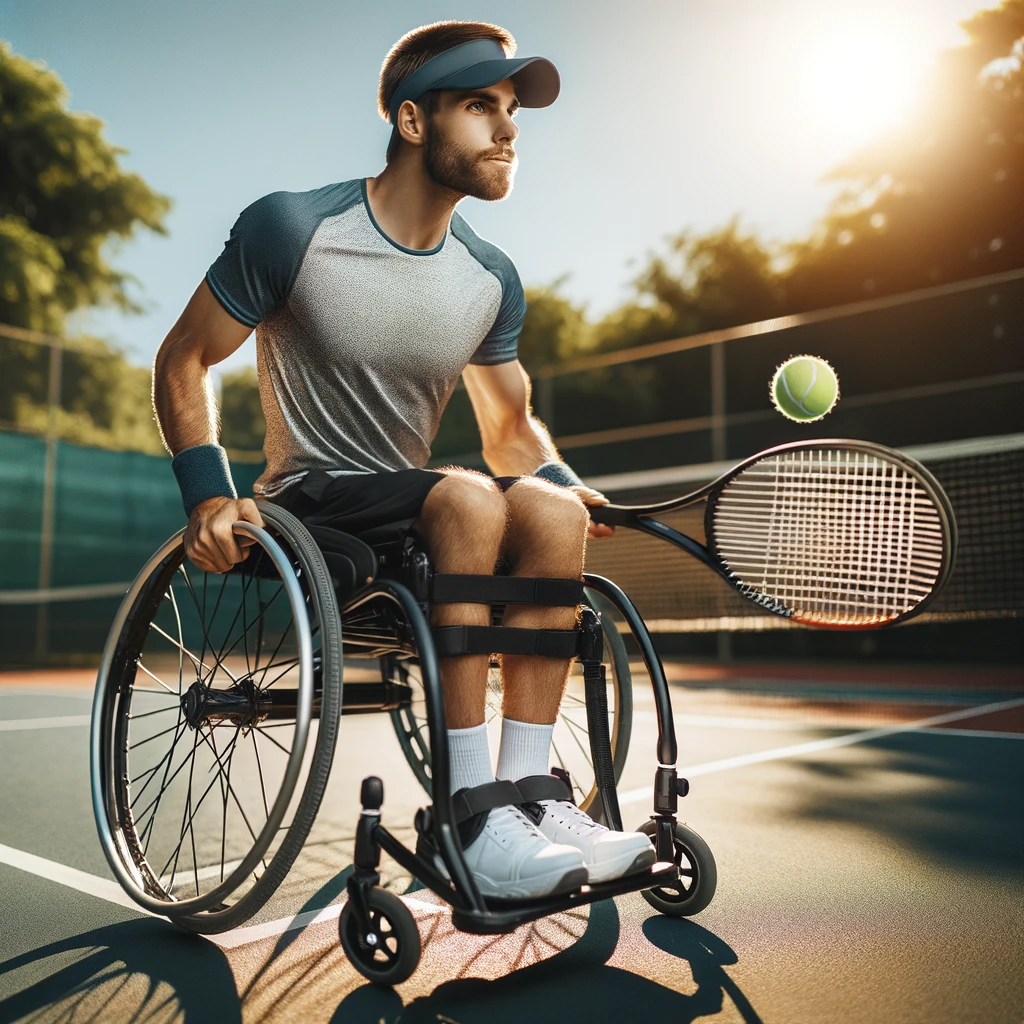Are you ready to take your tennis game to the next level?
Discover the world of adaptive tennis techniques that can be enjoyed by everyone, regardless of ability.
From equipment modifications to grip variations, footwork adaptations to stroke adjustments, this article will provide you with invaluable insights and strategies for inclusive play.
Get ready to elevate your game and embrace the power of adaptive tennis techniques that cater to every individual’s unique needs.
Let’s dive in and unlock the secrets to a more inclusive and fulfilling tennis experience.
Key Takeaways
- Equipment modifications such as wheelchair modifications, bracket attachment, anti-tip bars, and specialized sports wheels are essential for adaptive tennis.
- Grip variations and adaptations, including grip enhancers, modified racket handles, and adaptive aids, are crucial for players with limited grip strength.
- Footwork adaptations, including balance techniques, speed training, proper weight transfer, and efficient movement on the court, are important for improved performance.
- Stroke adjustments such as body positioning, modifying stance and follow-through, racket customization, and maximizing potential are necessary for adaptive players in tennis.
Equipment Modifications
When it comes to adaptive tennis techniques, equipment modifications play a crucial role in ensuring inclusivity and accessibility for all players. For wheelchair users, specific wheelchair modifications are necessary to enable them to move freely on the court and participate in the game.
These modifications can include attaching a bracket to the wheelchair to hold the tennis racket securely, as well as adding anti-tip bars to prevent the wheelchair from tipping over during quick movements. Additionally, wheelchairs can be equipped with specialized sports wheels that provide better traction on the court surface, allowing players to maneuver with ease.
Court surface adaptations are another important aspect of equipment modifications in adaptive tennis. Different court surfaces, such as clay, grass, or hard court, can have a significant impact on a player’s performance and mobility. To ensure inclusivity, it is essential to make necessary adaptations to the court surface.
This can involve adjusting the texture or grip of the playing surface to accommodate different wheelchairs or adding ramps and handrails for wheelchair access.
Grip Variations
To ensure optimal performance and adaptability in adaptive tennis, players must explore various grip variations that cater to their specific needs and abilities. Grip strength and hand positioning play crucial roles in achieving control, power, and accuracy in every shot.
Grip strength is essential for maintaining a firm hold on the racket throughout the game. Players with limited grip strength can use aids such as grip enhancers or modified racket handles to improve their grip. These adaptations provide players with a secure and comfortable grip, enabling them to generate more power and control over their shots.
Hand positioning is another crucial aspect of grip variations. Players can experiment with different hand positions on the racket handle to find the most suitable and comfortable grip. For example, players with limited finger dexterity may benefit from using a modified grip that allows them to hold the racket more securely using their palm and fingers.
Adaptive tennis players should also consider using adaptive aids, such as orthotic devices or specialized gloves, to help improve grip strength and hand positioning. These aids can provide additional support and stability, allowing players to focus on their technique and performance.
Footwork Adaptations
How can players adapt their footwork in adaptive tennis to optimize their performance?
Footwork is an essential aspect of any tennis player’s game, and adaptive tennis players are no exception. Adapting footwork techniques can help players achieve better balance, improve their speed, and ultimately enhance their overall performance on the court.
To optimize their performance, adaptive tennis players can employ the following footwork adaptations:
- Balance techniques: Maintaining good balance is crucial in adaptive tennis, especially for players with mobility impairments. Techniques such as widening the base of support, lowering the center of gravity, and using proper weight distribution can help players maintain stability and move more efficiently around the court.
- Speed training methods: Speed is a key factor in any tennis game, and adaptive players can benefit from specific training methods to improve their speed. These methods may include agility ladder drills, cone drills, and interval training. By focusing on quick, explosive movements and improving reaction time, players can enhance their ability to cover the court effectively.
- Proper weight transfer: In adaptive tennis, players must learn how to transfer their weight effectively to generate power and maintain balance. Mastering the technique of shifting weight from one foot to the other while maintaining stability can help players optimize their strokes and improve their overall footwork.
Stroke Adjustments
Adaptive tennis players can further enhance their performance by adjusting their strokes to accommodate their specific needs and abilities. When it comes to stroke adjustments, two key factors to consider are body positioning and racket customization.
Body positioning plays a crucial role in stroke adjustments for adaptive tennis players. Depending on their physical limitations, players may need to modify their stance, grip, or follow-through. For example, players with limited mobility in their legs might need to rely more on upper body strength and positioning to generate power and accuracy in their shots. By adapting their body positioning, players can maximize their potential and achieve better results on the court.
Racket customization is another important aspect of stroke adjustments. Adaptive tennis players may need to modify their racket to suit their specific needs. This can include adjusting the grip size, weight, or string tension to enhance control and maneuverability. For instance, players with limited hand strength may benefit from a lighter racket or a larger grip size to improve their hold and swing. Customizing the racket allows players to optimize their stroke mechanics and overcome physical limitations.
Strategies for Inclusive Play
What strategies can be implemented to promote inclusive play in adaptive tennis?
- Communication techniques: Effective communication is crucial for creating an inclusive environment in adaptive tennis. Coaches, players, and officials should be trained in various communication methods, such as sign language, visual cues, and clear verbal instructions. This ensures that everyone can understand and participate in the game regardless of their abilities.
- Inclusion in competition: To promote inclusive play, it is essential to provide opportunities for adaptive tennis players to compete at all levels. This can be achieved by organizing tournaments and leagues specifically designed for adaptive tennis. Additionally, integrating adaptive players into mainstream competitions can foster inclusivity and raise awareness about adaptive tennis.
- Equipment and court modifications: Making necessary modifications to the equipment and courts can enhance the inclusiveness of adaptive tennis. This includes using specialized adaptive equipment like wheelchairs, modified racquets, and balls with audible cues. Court modifications may involve creating accessible pathways, installing ramps, and adjusting court dimensions to accommodate different mobility needs.
Frequently Asked Questions
Can Adaptive Tennis Equipment Modifications Be Used in Regular Tennis Matches?
Adaptive tennis equipment modifications can indeed be used in regular tennis matches. These adaptations offer numerous benefits, such as improving accessibility, enhancing performance, and creating a more inclusive and diverse playing environment for all players.
Are There Any Specific Grip Variations That Are Recommended for Players With Physical Disabilities?
When it comes to adaptive tennis equipment, there are specific grip variations that are recommended for players with physical disabilities. These grips can be modified to accommodate individual needs and enhance the player’s performance on the court.
How Can Footwork Adaptations Help Improve a Player’s Overall Performance in Adaptive Tennis?
Footwork adaptations in adaptive tennis can significantly enhance a player’s overall performance. By making adjustments to their foot positioning, movement patterns, and agility techniques, players can improve their ability to reach shots and maintain balance, leading to better on-court performance.
Are There Any Stroke Adjustments That Can Be Made to Accommodate Players With Visual Impairments?
Stroke modifications and techniques for visually impaired players in adaptive tennis are crucial for ensuring inclusivity and equal opportunities. By making adjustments to accommodate visual impairments, players can fully participate and excel in the sport.
What Are Some Strategies for Promoting Inclusive Play in Adaptive Tennis Tournaments or Competitions?
Inclusive play strategies in adaptive tennis tournaments or competitions involve creating a welcoming environment, offering equipment modifications to accommodate different abilities, providing clear communication, and promoting teamwork and sportsmanship among participants.
Conclusion
In conclusion, adaptive tennis techniques offer a world of possibilities for players of all abilities. By making simple equipment modifications, experimenting with different grips, adapting footwork, adjusting strokes, and implementing strategies for inclusive play, tennis becomes an inclusive and accessible sport for everyone.
These techniques not only enhance the playing experience but also promote a sense of empowerment and inclusivity. So, let’s grab a racket, embrace these adaptive techniques, and unleash our potential on the tennis court.








No Comment! Be the first one.